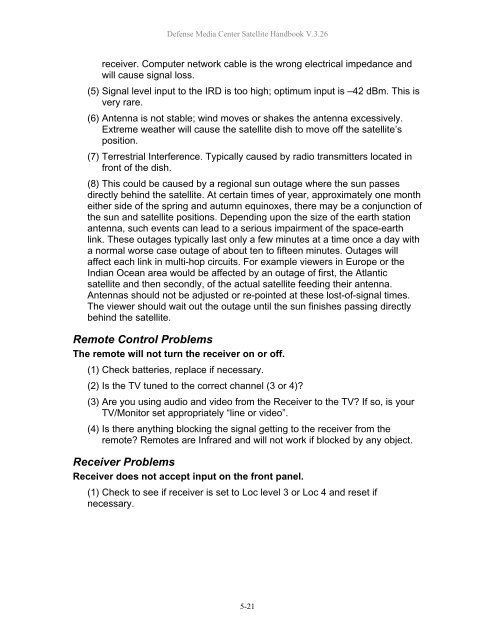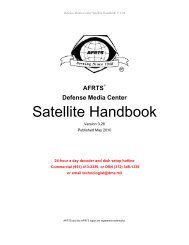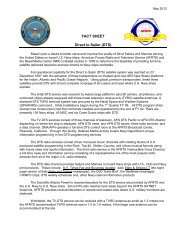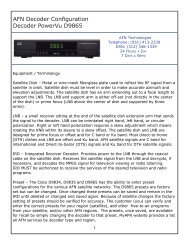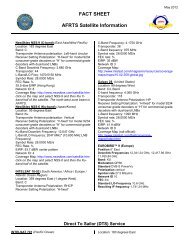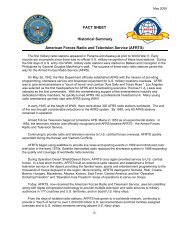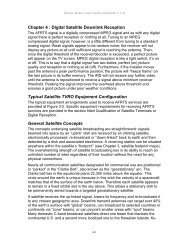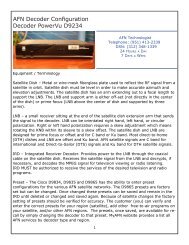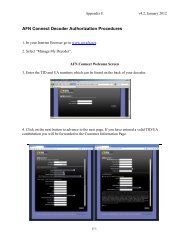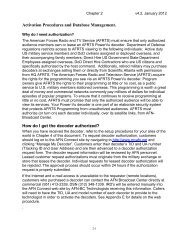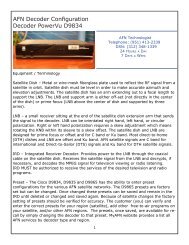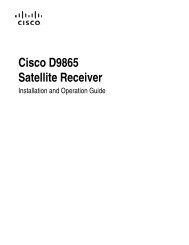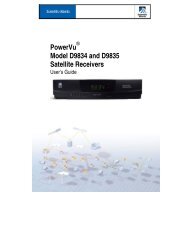AFRTS Defense Media Center Satellite Handbook
AFRTS Defense Media Center Satellite Handbook
AFRTS Defense Media Center Satellite Handbook
Create successful ePaper yourself
Turn your PDF publications into a flip-book with our unique Google optimized e-Paper software.
<strong>Defense</strong> <strong>Media</strong> <strong>Center</strong> <strong>Satellite</strong> <strong>Handbook</strong> V.3.26<br />
receiver. Computer network cable is the wrong electrical impedance and<br />
will cause signal loss.<br />
(5) Signal level input to the IRD is too high; optimum input is –42 dBm. This is<br />
very rare.<br />
(6) Antenna is not stable; wind moves or shakes the antenna excessively.<br />
Extreme weather will cause the satellite dish to move off the satellite’s<br />
position.<br />
(7) Terrestrial Interference. Typically caused by radio transmitters located in<br />
front of the dish.<br />
(8) This could be caused by a regional sun outage where the sun passes<br />
directly behind the satellite. At certain times of year, approximately one month<br />
either side of the spring and autumn equinoxes, there may be a conjunction of<br />
the sun and satellite positions. Depending upon the size of the earth station<br />
antenna, such events can lead to a serious impairment of the space-earth<br />
link. These outages typically last only a few minutes at a time once a day with<br />
a normal worse case outage of about ten to fifteen minutes. Outages will<br />
affect each link in multi-hop circuits. For example viewers in Europe or the<br />
Indian Ocean area would be affected by an outage of first, the Atlantic<br />
satellite and then secondly, of the actual satellite feeding their antenna.<br />
Antennas should not be adjusted or re-pointed at these lost-of-signal times.<br />
The viewer should wait out the outage until the sun finishes passing directly<br />
behind the satellite.<br />
Remote Control Problems<br />
The remote will not turn the receiver on or off.<br />
(1) Check batteries, replace if necessary.<br />
(2) Is the TV tuned to the correct channel (3 or 4)?<br />
(3) Are you using audio and video from the Receiver to the TV? If so, is your<br />
TV/Monitor set appropriately “line or video”.<br />
(4) Is there anything blocking the signal getting to the receiver from the<br />
remote? Remotes are Infrared and will not work if blocked by any object.<br />
Receiver Problems<br />
Receiver does not accept input on the front panel.<br />
(1) Check to see if receiver is set to Loc level 3 or Loc 4 and reset if<br />
necessary.<br />
5-21


